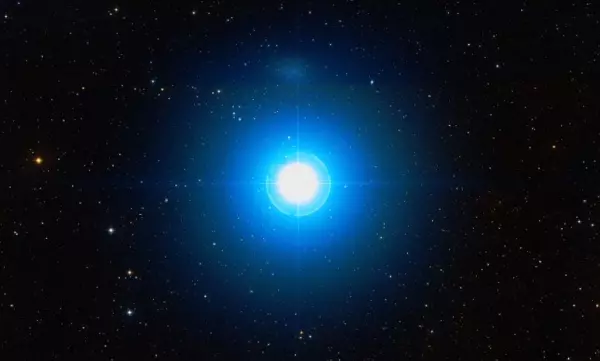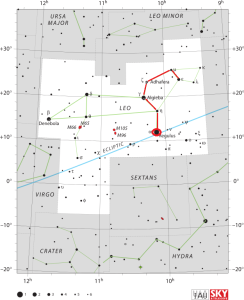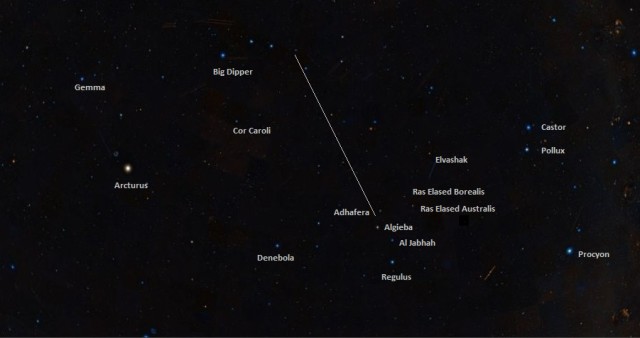Regulus, also known as Alpha Leonis, is the brightest star in the constellation Leo and the 21st brightest star in the night sky. It has an apparent magnitude of 1.35 and lies at a distance of 79.3 light years, or 24.3 parsecs, from Earth. Alpha Leonis is not really a single star, but a multiple star system.
The name Regulus means the “little king“ or “prince“ in Latin and the star is also known as Basiliskos, Cor Leonis (Lion’s Heart), Qalb al-Asad and Rex.
Regulus A, the primary component in the Regulus system, is a spectroscopic binary star composed of a blue-white main sequence star with the spectral classification B7 V and a companion believed to be a white dwarf.
With a visual magnitude of 1.35, Regulus A is reponsible for the star system’s brightness and bluish colour. It is the only visible component in the Regulus system.
Regulus B can be seen with binoculars, while Regulus C would require a larger telescope to be seen isolated from the system. Together, the Regulus BC pair can be seen in small telescopes.

Regulus (Alpha Leonis). Image: Wikisky
Regulus can be seen in the night sky throughout the year except for a month on either side of August 22, when the Sun comes too close to the star.
The star’s heliacal rising, first appearance above the horizon after a period of invisibility, occurs in the first week of September for observers in most locations. The planet Venus passes the star around this time every eight years.
The best time of year to observe Regulus from the northern hemisphere is in the late winter and early spring, when the star can be seen in the southern sky in the evening.
Facts
Regulus lies only 0.46 degrees from the ecliptic, the Sun’s apparent path across the sky, through the zodiac constellations, and is regularly occulted by the Moon and very rarely by Mercury and Venus. Venus last occulted Regulus on July 7, 1959 and will do so again on October 1, 2044. Occultation by other planets will not be seen for another few millennia.
Alpha Leonis can also sometimes be occulted by asteroids, the minor planets in the inner solar system. For instance, 163 Erigone, a large, dark asteroid from the asteroid belt, about 73 kilometres in size, occulted Regulus on March 20, 2014. 166 Rhodope, an asteroid about 54.6 kilometres in size, occulted the star on October 19, 2005.
Regulus is known by many different names in different cultures. The name Regulus is a diminutive form of “rex,“ which is Latin for “king.“ It was the Polish astronomer and mathematician Nicolaus Copernicus who gave the star this name, which was equivalent to Basiliskos (“little king”), used by the Greek astronomer Ptolemy. The star is also known by its Latin name Cor Leonis and the Arabic Qalb al-Asad (Kalb al Asad, Kabeleced). Both phrases mean Lion’s Heart.
Babylonian astronomers knew the star as Sharru (“the King”), Persians called it Miyan (“the Centre”) and in India the star was called Maghā (“the Mighty”). In Persia, Regulus was one of the four Royal Stars, along with Aldebaran in Taurus, Antares in Scorpius and Fomalhaut in Piscis Austrinus. In the MUL.APIN, a Babylonian catalogue of stars and constellations, Regulus was listed as LUGAL, referring to “the star that stands in the breast of the Lion: the King.”
In medieval astrology, Regulus was one of the 15 Behenian fixed stars, which were believed to have influence on one or more planets.
Regulus has often been used in works of fiction. It appears the television series Babylon 5, Star Trek: The Original Series, Star Trek: The Next Generation and Star Trek: Enterprise among others, and also in the computer games BattleTech, Frontier: Elite II, Frontier: First Encounters and Descent: FreeSpace.
Star system
The Regulus star system consist of four components, or two pairs of stars. The brighter pair, designated Regulus A, is a spectroscopic binary system consisting of a bright blue star and a companion that has not been directly observed, but is likely a white main sequence star with an unusually low mass of only 0.3 solar. The two stars complete an orbit around a common centre of mass every 40.11 days. They are separated by only 0.35 astronomical units. The companion was only discovered in 2008.
The primary component of Regulus A has 3.8 solar masses and is only a few million years old. The star is an exceptionally fast spinner, with a rotational velocity of 347 km/s. It completes a rotation in only 15.9 hours and, as a result, its shape has been distorted into an oblate spheroid, with the equatorial diameter 32 percent larger than the polar diameter. If the star were spinning only 10 percent faster, it would fly apart as its gravity would not be strong enough to hold it together. As a result of the star’s rapid rotation, its poles are five times brighter and significantly hotter than its equatorial region.
The other pair of stars in the Regulus system, designated Regulus B and Regulus C, are fainter main sequence stars belonging to the spectral classes K1-2 V and M5 V. In other words, Regulus B is an orange dwarf and Regulus C, a red one. The stars have an orbital period of 2,000 years and the distance between them is about 100 astronomical units. The Regulus BC pair lies about 177 arc seconds or 4,200 astronomical units away from Regulus A.
Location

Regulus and the Sickle of Leo. Image: IAU and Sky & Telescope magazine (Roger Sinnott & Rick Fienberg)
Regulus is pretty easy to find in the sky. The star is part of the Sickle of Leo, a prominent asterism in the constellation Leo, and marks the lower end of the Sickle‘s handle. The asterism looks like a backwards question mark and outlines the head of the celestial lion.
The Sickle of Leo can be located using the stars of the Big Dipper.
Megrez and Phecda, the two inner stars of the Dipper’s bowl, point the way to the asterism much like Dubhe and Merak, the outer stars of the bowl, point the way to Polaris.
Regulus – Alpha Leonis
Constellation: Leo
Spectral class: B7 V (Regulus A), K1-2 V (Regulus B), M5 V (Regulus C)
Coordinates:
Regulus A: 10h 08m 22.311s (right ascension), +11° 58′ 01.95″ (declination)
Regulus BC: 10h 08m 12.8/14s (right ascension), +11° 59′ 48″ (declination)
Distance: 79.3 light years (24.3 parsecs)
Designations: Regulus, Alpha Leonis, α Leonis (α Leo), Cor Leonis, Lion’s Heart, Basiliskos, Rex, 32 Leonis, Qalb al-Asad, Kalb al Asad, Kabeleced, HR 3982, GJ 9316, HIP 49669, FK5 380, GCTP 2384.00
Regulus A: HD 87901, SAO 98967, BD+12 2149, LTT 12716
Regulus B: HD 87884, SAO 98966, BD+12 2147, LTT 12714
Apparent magnitude: 1.35 (Regulus A), 8.14 (Regulus B), 13.5 (Regulus C)
Absolute magnitude: –0.52 (Regulus A), 6.3 (Regulus B), 11.6 (Regulus C)
Mass: 3.8 solar masses (Regulus A), 0.8 (Regulus B), 0.2 (Regulus C)
Radius: 3.092 solar radii (Regulus A), 0.5 (Regulus B)
Luminosity: 288 solar luminosities (Regulus A), 0.31 (Regulus BC)
Surface temperature: 12,460 K (Regulus A)
Rotational velocity: 347 km/s (Regulus A)
